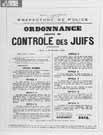
|
|
|

|

|

|

|
|
Click on an image to see a larger, more detailed picture.
|
|
|
|
|
| 1940: Machinery of Hatred |

|
pg. 204 |

|
|
|
|
| |
 On October 3, 1940, the Vichy government of France passed the first Statut des Juifs (Jewish Statute). The law was modeled on the German Nuremberg Laws. Jews living in Vichy France were required to have their identification cards stamped with the word Juif (Jew). Moreover, they were not permitted to change residences, and they had to inform the police about any changes in marital status. The laws effectively enabled the regime to keep tabs on the Jews.
On October 3, 1940, the Vichy government of France passed the first Statut des Juifs (Jewish Statute). The law was modeled on the German Nuremberg Laws. Jews living in Vichy France were required to have their identification cards stamped with the word Juif (Jew). Moreover, they were not permitted to change residences, and they had to inform the police about any changes in marital status. The laws effectively enabled the regime to keep tabs on the Jews.
Photo: United States Holocaust Memorial Museum Photo Archive
|
 A Jewish refugee and his young daughter stand in Lisbon, Portugal, by the Greek ship Nea Hellas. Scheduled to depart for the United States in October 1940, the voyage was canceled after the Italian invasion of Greece. Some 12,000 refugees were stranded in Lisbon, a major gateway for those holding immigration visas.
A Jewish refugee and his young daughter stand in Lisbon, Portugal, by the Greek ship Nea Hellas. Scheduled to depart for the United States in October 1940, the voyage was canceled after the Italian invasion of Greece. Some 12,000 refugees were stranded in Lisbon, a major gateway for those holding immigration visas.
Photo: American Jewish Joint Distribution Committee / United States Holocaust Memorial Museum Photo Archive
|
 Vichy and the Jews
Vichy and the Jews
From 1940 to 1944, all of France was occupied by the Nazis except for the southern third. However, that southern zone, known as Vichy, was ruled by an equally antisemitic government, led by Marshal Philippe Pétain. The Vichy regime enacted discriminatory and humiliating policies against Jews, which culminated in arrests, internments, and deportations to Nazi death camps. Few victims survived. One-third of the 84,000 Jews deported from France came from this unoccupied zone. Vichy passed the "Jewish Statute," which racially defined "Jewishness" and barred Jews from positions of authority. A census located Jews and listed their addresses, jobs, and wealth. Juif (Jew) stamps marked ration cards and identity papers. Yellow posters identified Jewish businesses, while "Aryanization" robbed them of their property. Non-French Jews fared worse. Roundups of "undesirable refugees" netted 30,000 Jews. Thrown into special camps, 3000 people died because of deplorable conditions. At Gurs, in the Pyrénées Mountains, 1167 died of starvation, dysentery, and typhoid. At Rivesaltes, where children were imprisoned separate from their mothers, mortality rates were equally high. Horrible sanitary conditions; lack of food, water, and adequate shelter from the cold; and sadistic harassment by guards were standard features of Vichy's concentration camps. In time, deportation to the East emptied the camps.
|
|

|

|

|

|
 October 1940: 6500 Jews are deported from Germany's Palatinate, Baden, and Saar regions to internment camps at the foot of the French Pyrénées.
October 1940: 6500 Jews are deported from Germany's Palatinate, Baden, and Saar regions to internment camps at the foot of the French Pyrénées.
|
 October 1940: Jews are forced to pay for and build a wall around the Warsaw (Poland) Ghetto.
October 1940: Jews are forced to pay for and build a wall around the Warsaw (Poland) Ghetto.
|
 October 1940: Reich theoretician Alfred Rosenberg writes an article, "Jews to Madagascar," which suggests mass deportation of Jews to the island off the African coast.
October 1940: Reich theoretician Alfred Rosenberg writes an article, "Jews to Madagascar," which suggests mass deportation of Jews to the island off the African coast.
|
 October 1940: German authorities forbid Norwegian Jews to teach and participate in other professions.
October 1940: German authorities forbid Norwegian Jews to teach and participate in other professions.
|
 October 1, 1940: Young Jewish men return from the Belzec, Poland, camp to Szczebrzeszyn, Poland, after a ransom of 20,000 zlotys is paid to Nazi captors.
October 1, 1940: Young Jewish men return from the Belzec, Poland, camp to Szczebrzeszyn, Poland, after a ransom of 20,000 zlotys is paid to Nazi captors.
|
|
|
|
|
| 1940: Machinery of Hatred |

|
pg. 204 |

|
|
The Holocaust Chronicle
© 2009 Publications International, Ltd.
|
|
